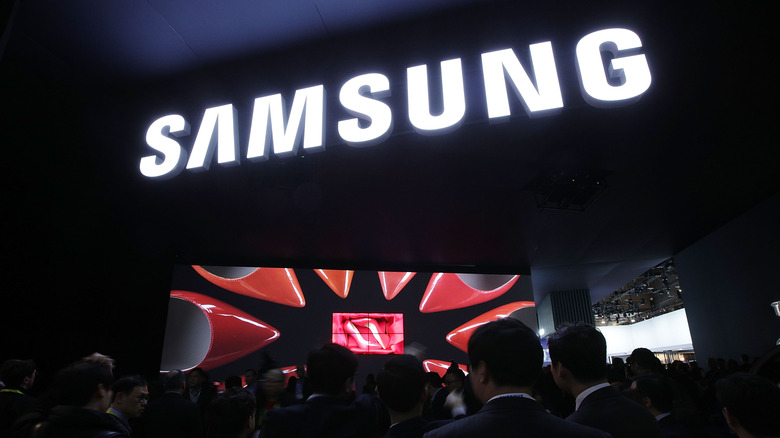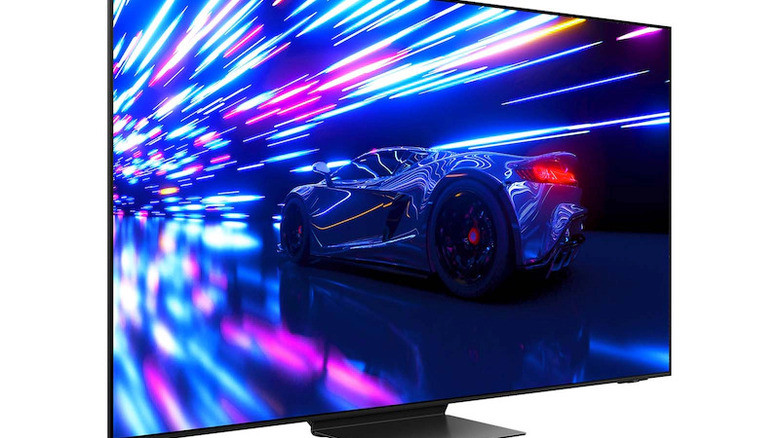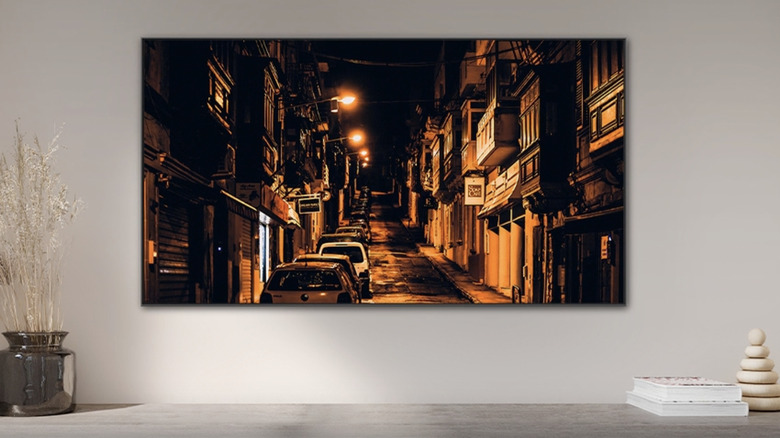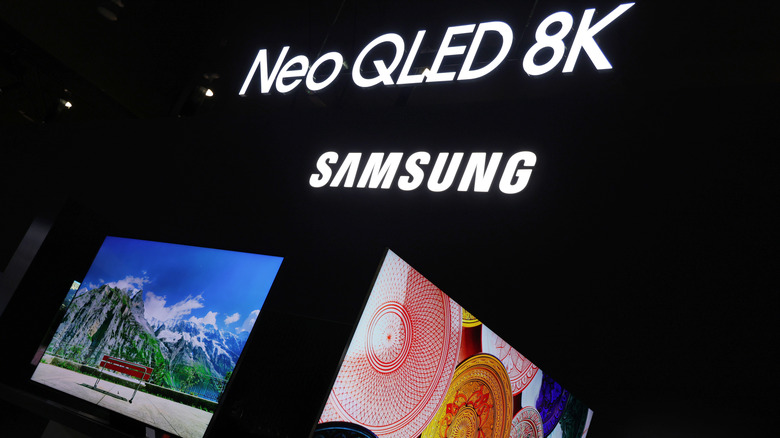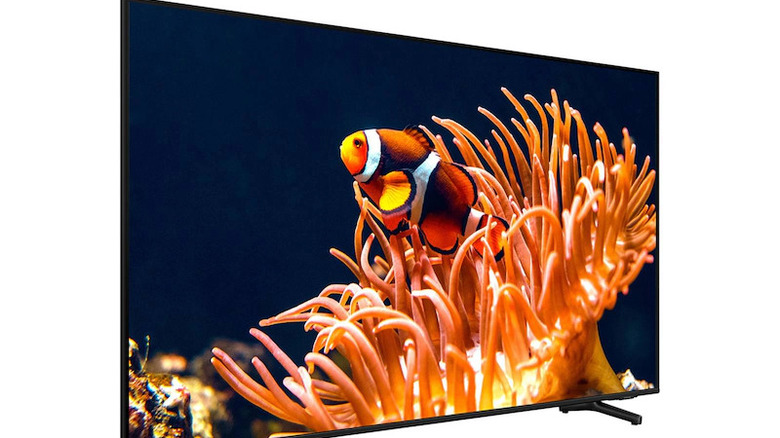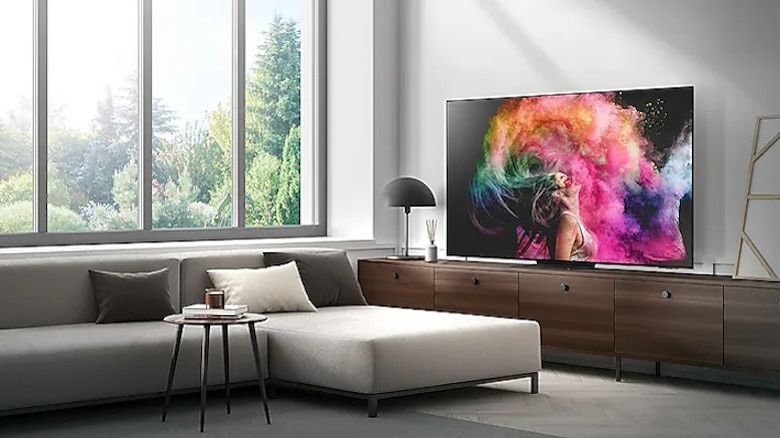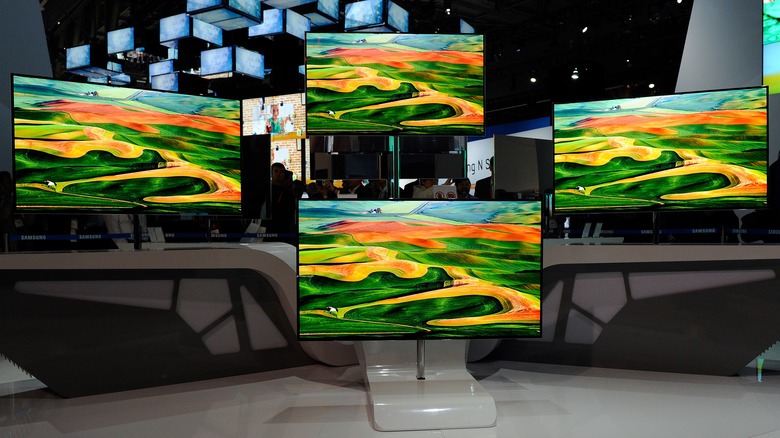6 Of The Highest Rated Samsung TVs For 2024
We may receive a commission on purchases made from links.
If you are someone who is in the market for a new television, chances are pretty good that the first brand you are going to think about is Samsung. The South Korean company makes up about one-third of the televisions currently owned in the United States, and every single year, they keep coming out with new models that improve on the previous years. Whether you're looking for a budget-friendly 4K television or a forward-looking 8K behemoth, Samsung is sure to have a screen that will satisfy all of your movie and television-watching or game-playing needs.
Most people wanting to stay current with their TVs think about getting a 4K TV, and while that is a good starting place, that is an incredibly vague descriptor that simply points to the pixel resolution of the screen. Samsung offers a plethora of 4K and 8K TVs, but attached to those are a bunch of letters and numbers that may mean nothing to the average person and get them confused as to which model is right for what they want to use the screen for. Well, with this piece, we are going to spotlight six different Samsung televisions on the market that cover a range of prices and technologies that come highly rated from a variety of different publications' reviews, and hopefully, this little guide will steer you in the right direction as to which Samsung TV you should purchase.
Samsung S95D
For those looking for the best of the best when it comes to Samsung televisions, you are ultimately going to come down to a choice between two different technologies: OLED and QLED. Prior to this most recent generation of TVs, you were probably familiar with the term LCD. Well, a QLED has quite a lot in common with an LCD screen but adds a layer of quantum dots. Mini LED backlights emit these dots and give the colors a distinct vibrancy.
OLED, on the other hand, uses OLED subpixels to produce light rather than LEDs. Where OLED TVs shine is in the contrast of their colors and their deep blacks, making for about as vivid an image as one could possibly hope for from a Samsung TV. If money is no barrier, then pick an OLED TV over a QLED, particularly if you are someone who typically uses it to watch movies. The Samsung S95D is the company's premiere OLED TV, and it takes the extremely highly rated S95C model from last year and just improves everything about it, from upping the vibrancy to deepening the black levels even further and improving HDR production.
If you are looking for a good financial deal on a TV, the Samsung S95D is not going to provide that. This is a brand new product, and the cheapest you can get it is $2,599.99 for a 55-inch model. It's a top-of-the-line product, and it is priced as such.
Samsung QN90D
Even though we prefer an OLED TV model to a QLED one, that doesn't mean that a QLED will not deliver a tremendous picture. Samsung has been pushing its QLED models — or, as it's now known now, Neo QLED — for many years, and they also get plenty of sterling reviews across the board. The latest in Samsung's Neo QLED line is the QN90D, which is sure to satisfy most people's desires for a new television. The biggest selling point when it comes to Neo QLED models is the brightness. Most people are looking to put a new television in their living rooms, and if you are someone who tends to use it a lot during the daytime when a lot of light is entering your home, having a bright Neo QLED display can make seeing detail in the image a lot easier.
Another reason you might be interested in checking out the Samsung QN90D is that it is more affordable than its OLED counterpart. For the same 55-inch size of the S95D, you can get a QN90D for $1,999.99. That is still quite a bit of money, but Samsung offers a wider range in sizes for its Neo QLED TVs than OLEDs. You can go all the way down to $1,499.99 for a 43-inch model if you want. If money isn't your issue, the QN90D can also come in much larger sizes than the S95D, as the former can reach up to 98 inches, whereas the latter maxes out at 77 inches.
Samsung QN900D
Both of the televisions mentioned already produce a 4K resolution. This is pretty standard for today's TVs, and most people will be perfectly fine with that being the maximum resolution. However, Samsung can go even further if you want it. In its Neo QLED line, Samsung also has the QN900D, which is an 8K version of the previous Neo QLED model. This is the TV that Samsung describes as its "flagship TV," and its understandable as to why. This contains all of the brightness, vibrancy, and power of the QN90D, but it does so with four times as many pixels and increased processing power to deliver an image of such clarity that you can hardly believe it.
If you thought the OLEDs were expensive, then this will shock you. The lowest price you can get a Samsung QN900D is $4,999.99 for a 65-inch model. That number may dissuade folks who can even afford it comfortably when you take into account that there is almost no 8K content out there yet that is widely available to enjoy. While that is true, 8K is on the horizon, and in the meantime, the processing power of this television will be able to handle all of your 4K material at the highest level. So, not only are you looking towards the future, but you still get to maximize the present with a QN900D.
Samsung Crystal UHD DU8000
If you have gotten to this point on the list, it would not be shocking if you have been dismayed at the prices of these televisions. With 4K being so prevalent today, you may be wondering how anyone could possibly afford to have 4K in their homes. Well, there are 4K TVs out there that are more budget-friendly, and Samsung makes these models as well. For a 4K TV that won't kill your bank account, look no further than the Samsung Crystal UHD DU8000.
While it may not have the processing power, brightness, or contrast of the previously mentioned models, this is still an image that will get you all the resolution you need and also supports HDR material. You just don't have the enhanced display technology that Neo QLED or OLED models do, so the images aren't going to pop in the same way as on those TVs. Instead of a great looking TV, a Crystal UHD DU8000 will get you a very good one.
The most appealing part of this class of Samsung TV is the price. The least expensive TV mentioned so far was $1,499.99. With a Crystal UHD DU8000, you can get one for the low, low price of $399.99 for a 43-inch model. That is an astounding drop in price, and the most expensive version of this model is $1,699.99. With that, you are getting a massive 85-inch television. If you need to save some cash, then this is the Samsung TV you want to be looking at.
Samsung The Frame LS03D
One of the more unique offerings Samsung has in its television department is what's known as The Frame. Every other person with a TV just has to be content with having this big, black rectangle on their wall or sitting on their cabinet until they go to turn it on again. The Frame LS03D looks to eliminate what some consider to be an aesthetic eyesore. This is a television designed to be mounted flush against the wall as if you were hanging a photograph or an art print. The border of the TV is meant to mimic this feeling as well. So, when you are not actively using your television, The Frame can act like any other art piece you might hang in a room rather than look like a TV.
Don't be misled, though. This is still a QLED TV, though it differs from the QN models mentioned previously, as it uses a traditional LED lighting system rather than Mini LEDs. The result is an image that doesn't quite reach the vibrancy and brightness of its QLED counterpart, but it's still a pretty good image. You are still treated to a quantum dot display, and it is set up for HDR and 120 Hz gaming (starting with the 55-inch model).
In terms of price, it sits comfortably between the Crystal UHD and QN models. Its starting price is $999.99 for a 43-inch model, and it goes up to $2,999.99 for a 75-inch one. If maximizing the power of your television is most important, The Frame might not be for you, but if you want to tie a room together with a good quality TV, it could be a fabulous addition.
Samsung S95C and other models from previous years
All of the Samsung television models mentioned are the company's 2024 models. They are the latest and greatest of what it has to offer. That being said, that does not mean that the models from 2023 are that far behind this year's. Each new year presents itself with incremental improvements rather than complete overhauls. Almost every year, Samsung's TVs receive high marks, so there really isn't much of a need to mess with the formula.
So, if you want to get a Samsung S95D OLED TV but would prefer the price to be a little lower, then perhaps you should look at the S95C from 2023, a widely heralded television. Instead of paying $2,599.99 for the 55-inch version of the latest model, you can pick up a 55-inch S95C for $1,899.99. Price decreases can be found in every corner of the Samsung TV department as well, even if they are relatively small, such as with the Crystal UHD models. The D in these TV model numbers indicates that it's a 2024 model, and the 2023 one replaces that with a C, making it rather easy to distinguish the two.
It should also be noted that there are variations within each model. To go back to the S95D OLED, there is also an S90D OLED, which drops that $2,599.99 price tag to $1,999.99 for a 55-inch model. You don't always have to go for the newest and highest-end Samsung to get a great television.
Why these Samsung TVs were chosen
Samsung sells many different televisions, so narrowing this list down to just six came down to a number of different factors. The first was to give the reader a wide view of the different kinds of televisions Samsung has to offer, which includes variations in price, screen resolution, and technology. Secondly, this list wanted to focus mostly on 2024 models of Samsung TVs.
If people are going to head out to various retail stores or shop online for a new television, chances are that the TVs they will encounter will be the new models, though older models are still available. Lastly, this list wanted to represent somewhat of a consensus of various publications that have reviewed these televisions — such as TechRadar, Business Insider, Popular Mechanics, PC Mag, Rtings, and ZDNet — and not just the opinion of this writer. However, this writer does have quite a bit of experience with Samsung televisions, which is why I make a judgment on things like OLED being a superior technology to Neo QLED. Combining all of these factors determined which models should be on this final list.
Now that you have your new TV, just remember to turn off motion smoothing. It doesn't matter what television you purchase. This is a must.
